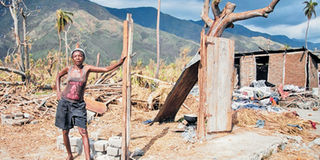Will Hurricane Matthew reset Haiti’s relief aid relationships?

A woman at the entrance to what is left of her home in Les Cayes. She has five children and no means to rebuild. PHOTO | IRIN
What you need to know:
- The death toll stands at 546, but contaminated water sources and destroyed health-care services are contributing to the rapid spread of cholera and the storm also killed livestock and wiped out crops in many areas where subsistence farmers were about to harvest.
The catastrophic earthquake that struck Haiti in January 2010 shocked the world and galvanised a massive international response. Just over two weeks after Hurricane Matthew left a trail of destruction across the southwest of the country, already the world appears to be moving on, despite warnings that the impact is severe.
The death toll stands at 546, but contaminated water sources and destroyed health-care services are contributing to the rapid spread of cholera and the storm also killed livestock and wiped out crops in many areas where subsistence farmers were about to harvest.
“The death toll from the earthquake was horrible and the injuries were much worse, but in terms of the lasting effects I think many people would agree there’s a chance this is even worse than the earthquake,” said Conor Shapiro, CEO of the St. Boniface Haiti Foundation which provides community-based healthcare and runs a hospital in southern Haiti.
“Is the international community going to see this as the massive disaster that it is?” he added.
The earthquake generated an estimated US$9 billion in aid. By now, it’s well known that the scale of that response was not matched by the outcomes. There was a lack of coordination between the hundreds of international NGOs that flocked to the country following the disaster, but more importantly with the Haitian government and local NGOs. Consultation with the people affected by the earthquake was also minimal, hampering relief efforts and creating a lasting mistrust of foreign aid workers.UN peacekeepers failed to adequately treat their waste-water resulting in a cholera outbreak that has claimed at least 10,000 lives.
According to Emily Troutman, a freelance journalist who was based in Port-au-Prince from 2010 to 2012 and now edits her own blog Aid.Works, just 3.5 per cent of the aid that poured into Haiti in the three years after the earthquake went to preparing for similar disasters.
In recent years, donor support to Haiti has dwindled. However needs remain: from cholera to drought to the assiting people still displaced by the earthquake, said Enzo Di Taranto, head of office for OCHA, the UN’s humanitarian coordination department, in Haiti. He noted that the 2016 humanitarian response plan for the country was only 32 per cent funded and that disaster preparedness was one of the most under-funded components, along with projects to strengthen government capacity. “There wasn’t a solid preparedness structure for a disaster we all knew was coming,” he told IRIN.
The government did have a contingency plan and its Department of Civil Protection together with the humanitarian community carried out evacuations in many coastal villages and small islands that Di Taranto said “saved many, many lives”.
The government and local NGOs broadcast public service announcements, warning local residents about the hurricane. According to Marilyn Lawney, executive director of the Haitian Health Foundation, which is based in hard-hit Jérémie, many people didn’t believe the warnings. Even if they had, she added, “I’m not sure what they could have done”. There were few buildings in the area that could withstand the Category 4 storm.
“Where do you go when the infrastructure is weak?” said Shaprio. “There were some shelters, but not enough.”
The World Food Programme had pre-positioned enough food to feed 300,000 people for three months ahead of hurricane season, but most of the aid was warehoused in the capital, Port-au-Prince. The difficulty of transporting supplies along damaged roads to often remote communities in the south meant that by October 18,WFP had only reached 77,000 of the estimated 806,000 people in urgent need of food aid.
The writer is IRIN’s Migration Editor




